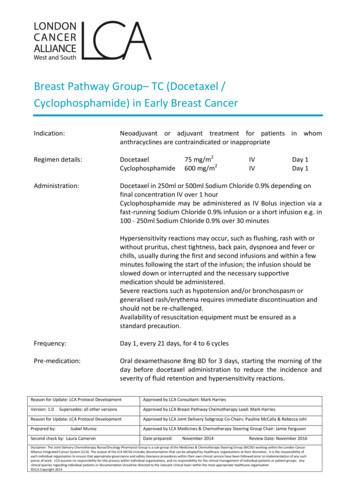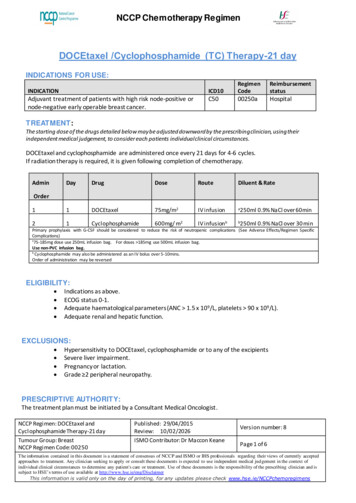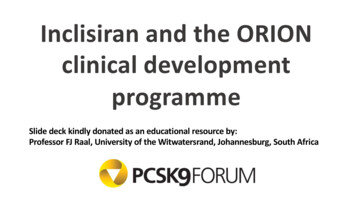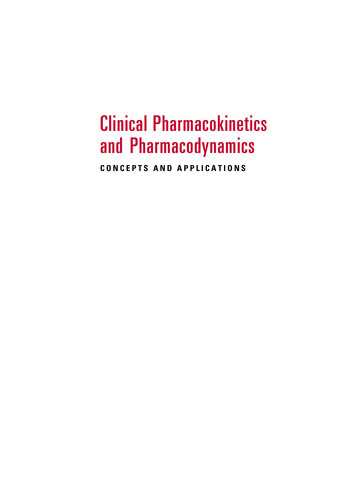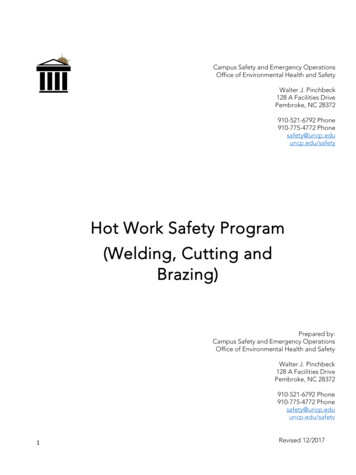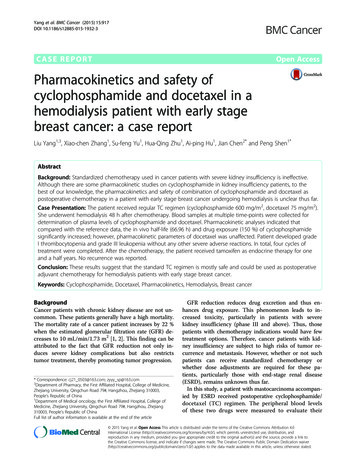
Transcription
Yang et al. BMC Cancer (2015) 15:917DOI 10.1186/s12885-015-1932-3CASE REPORTOpen AccessPharmacokinetics and safety ofcyclophosphamide and docetaxel in ahemodialysis patient with early stagebreast cancer: a case reportLiu Yang1,3, Xiao-chen Zhang1, Su-feng Yu1, Hua-Qing Zhu1, Ai-ping Hu1, Jian Chen2* and Peng Shen1*AbstractBackground: Standardized chemotherapy used in cancer patients with severe kidney insufficiency is ineffective.Although there are some pharmacokinetic studies on cyclophosphamide in kidney insufficiency patients, to thebest of our knowledge, the pharmacokinetics and safety of combination of cyclophosphamide and docetaxel aspostoperative chemotherapy in a patient with early stage breast cancer undergoing hemodialysis is unclear thus far.Case Presentation: The patient received regular TC regimen (cyclophosphamide 600 mg/m2, docetaxel 75 mg/m2).She underwent hemodialysis 48 h after chemotherapy. Blood samples at multiple time-points were collected fordetermination of plasma levels of cyclophosphamide and docetaxel. Pharmacokinetic analyses indicated thatcompared with the reference data, the in vivo half-life (66.96 h) and drug exposure (150 %) of cyclophosphamidesignificantly increased; however, pharmacokinetic parameters of docetaxel was unaffected. Patient developed gradeI thrombocytopenia and grade III leukopenia without any other severe adverse reactions. In total, four cycles oftreatment were completed. After the chemotherapy, the patient received tamoxifen as endocrine therapy for oneand a half years. No recurrence was reported.Conclusion: These results suggest that the standard TC regimen is mostly safe and could be used as postoperativeadjuvant chemotherapy for hemodialysis patients with early stage breast cancer.Keywords: Cyclophosphamide, Docetaxel, Pharmacokinetics, Hemodialysis, Breast cancerBackgroundCancer patients with chronic kidney disease are not uncommon. These patients generally have a high mortality.The mortality rate of a cancer patient increases by 22 %when the estimated glomerular filtration rate (GFR) decreases to 10 mL/min/1.73 m2 [1, 2]. This finding can beattributed to the fact that GFR reduction not only induces severe kidney complications but also restrictstumor treatment, thereby promoting tumor progression.* Correspondence: cj21 0503@163.com; zyyy sp@163.com2Department of Pharmacy, the First Affiliated Hospital, College of Medicine,Zhejiang University, Qingchun Road 79#, Hangzhou, Zhejiang 310003,People’s Republic of China1Department of Medical oncology, the First Affiliated Hospital, College ofMedicine, Zhejiang University, Qingchun Road 79#, Hangzhou, Zhejiang310003, People’s Republic of ChinaFull list of author information is available at the end of the articleGFR reduction reduces drug excretion and thus enhances drug exposure. This phenomenon leads to increased toxicity, particularly in patients with severekidney insufficiency (phase III and above). Thus, thosepatients with chemotherapy indications would have fewtreatment options. Therefore, cancer patients with kidney insufficiency are subject to high risks of tumor recurrence and metastasis. However, whether or not suchpatients can receive standardized chemotherapy orwhether dose adjustments are required for these patients, particularly those with end-stage renal disease(ESRD), remains unknown thus far.In this study, a patient with mastocarcinoma accompanied by ESRD received postoperative cyclophosphamide/docetaxel (TC) regimen. The peripheral blood levelsof these two drugs were measured to evaluate their 2015 Yang et al. Open Access This article is distributed under the terms of the Creative Commons Attribution 4.0International License (http://creativecommons.org/licenses/by/4.0/), which permits unrestricted use, distribution, andreproduction in any medium, provided you give appropriate credit to the original author(s) and the source, provide a link tothe Creative Commons license, and indicate if changes were made. The Creative Commons Public Domain De cyclophosphamide in kidney insufficiency patients have alreadybeen reported. Haubitz et al. [14] found that cyclophosphamide exposure increased as the severity of kidneydamage increased; for example, the cyclophosphamideexposure increased by 1.2-fold in patients with phase Vkidney damage. Ekhart et al. [15] investigated the pharmacokinetic changes of cyclophosphamide in patientswith moderate kidney insufficiency. They found that the67 % increase in cyclophosphamide exposure might be notsufficient to adjust the dosage. However, the changes in thepharmacokinetics of cyclophosphamide in hemodialysis patients remain unclear thus far. In the present study, although drug exposure significantly increased (150 %), thestandard dosage of cyclophosphamide was still found to berelatively safe for the mastectomy patient with ESRD. Infact, 1000 mg of cyclophosphamide as an imperative treatment can still be highly tolerated by patients with immune diseases, including lupus nephritis and chronickidney disease [16]. This finding may partially explainthe tolerance to high cyclophosphamide concentrationsobserved in this study.Docetaxel is not usually administered to patients withrenal insufficiency because of its low excretion rate via
Yang et al. BMC Cancer (2015) 15:917the kidneys. Dimopoulos et al. [17] investigated the effects of docetaxel in patients with urinary tract tumorsand late-stage kidney damage. They found that the toxiceffects of docetaxel slightly increased in patients withkidney damage. However, the study did not investigatethe pharmacokinetic characteristics of docetaxel. Thepresent study showed that the pharmacokinetic parameters of docetaxel remained unaffected and were comparable to those in the reference group, thereby meeting thetwo-compartment model. Doxetaxel exposure slightlyincreased, but no relative toxic effects on the patientwere observed. Similarly, postoperative breast cancer patients with ESRD can adapt to the normal dosage ofdocetaxel.Another interesting finding in our study is thathemodialysis did not significantly influence the clearanceof cyclophosphamide and docetaxel. There are a few casereports on pharmacokinetics of cyclophosphamide anddocetaxel in patients undergoing hemodialysis. Haubitz Met al. [14] studied the effects of hemodialysis on thepharmacokinetics of cyclophosphamide, and proved thatthe plasma concentration of cyclophosphamide decreasedby 10 % after hemodialysis, while Hochegger K et al. [18]revealed that following hemodialysis, the concentration ofdocetaxel decreased by nearly 92 %. However, in thisstudy, the plasma concentrations of cyclophosphamideand docetaxel decreased by only 6.9 % and 2.9 % afterhemodialysis, respectively, probably owing to individualvariability of cyclophosphamide clearance and low concentration of docetaxel in plasma at 48 h that led to limited elimination by hemodialysis. Therefore, we speculatethat the decreased drug toxicity was not attributed tohemodialysis. However, the white blood cell count of thepatient increased to 40.5 109/L during the treatmentprocess. This result is attributable to the application ofGCSF. As a macromolecular protein with a molecularweight of approximately 20000, GCSF will accumulate inthe body because it cannot be completely eliminated byhemodialysis in the present study. The conventional dosage of short-term GCSF might markedly increase whiteblood cell and neutrophilic granulocyte count. The whitecell count of the patient gradually normalized upon discontinuation of GCSF for 1 week. Therefore, the dosageand frequency of GCSF should be adjusted accordingly inhemodialysis patients.This study has two limitations. First, we did not measure the metabolites of cyclophosphamide and docetaxelowing to unavailability of the standard metabolites required for such analysis, which might explain the lack ofpublished data on such metabolites. Ekhart C et al. demonstrated that the active metabolites of cyclophosphamide were not significantly affected in conditions ofrenal impairment, similar to the condition described inthe present study [6]. Second, the generalizability of thePage 4 of 5case still needs to be verified. Despite these limitations,this study is the first to present the pharmacokineticdata of cyclophosphamide and docetaxel in a breast cancer patient with ESRD. Overall, the TC regimen is probably safe and could be used for similar cases.ConsentWritten informed consent was obtained from the patientfor publication of this case report. A copy of the writtenconsent is available for review by the editor of thisjournal.AbbreviationsGFR: Glomerular filtration rate; ESRD: End-Stage Renal Disease;TC: Cyclophosphamide/docetaxel; GCSF: Granulocyte colony stimulating factor;LC-MS/MS: Triple quadrupole liquid chromatography-mass spectrometer.Competing interestsThe authors declare that they have no competing interests.Authors’ contributionsAll authors fulfill the authorship criteria because of their substantialcontributions to the conception, design, analysis, and interpretation of thedata. LY and JC analyzed the data and drafted the manuscript. LY and PSprovide the financial support for this study. SFY, HQZ, and APH participatedin the patient’s blood collection. LY, JC, PS and XCZ conceived the study,and participated in its design and in data acquisition. All authors read andapproved the final manuscript.AcknowledgementsWe thank Xiao-dan Wu, Shi-min Li from analysis and measurement center ofZhejiang University for doing the LC-MS/MS analysis.Supported by the National High Technology Research and DevelopmentProgram of China (863 Program, No. 2012AA02A205), and the NationalNatural Science Foundation of China for Youth (No. J20121214 and No.81301892), and the Medical Science Research Foundation of Health Bureauof Zhejiang Province (No. 2012KYB070).Author details1Department of Medical oncology, the First Affiliated Hospital, College ofMedicine, Zhejiang University, Qingchun Road 79#, Hangzhou, Zhejiang310003, People’s Republic of China. 2Department of Pharmacy, the FirstAffiliated Hospital, College of Medicine, Zhejiang University, Qingchun Road79#, Hangzhou, Zhejiang 310003, People’s Republic of China. 3Department ofMedical Oncology, Zhejiang Provincial People’s Hospital, Hangzhou 310014,People’s Republic of China.Received: 5 September 2014 Accepted: 13 November 2015References1. Armstrong AE, Dargart J, Reichek J, Walterhouse DO, Matossian D, Cohn RA, et al.Irinotecan and temozolomide for treatment of neuroblastoma in a patient withrenal failure on hemodialysis. Pediatric blood & cancer. 2014;61:949–50.2. Magee C. Kidney disease and death from cancer. American journal ofkidney diseases: the official journal of the National Kidney Foundation.2014;63:7–9.3. National Comprehensive Cancer Network. NCCN Guideline for breastcancer. Available at http://www.nccn.org/professionals/physician gls/fguidelinesasp#breast 2014.4. de Jonge ME, Huitema AD, Rodenhuis S, Beijnen JH. Clinical pharmacokineticsof cyclophosphamide. Clin Pharmacokinet. 2005;44:1135–64.5. Bruno R, Riva A, Hille D, Lebecq A, Thomas L. Pharmacokinetic andpharmacodynamic properties of docetaxel: results of phase I and phase II trials.American journal of health-system pharmacy: AJHP: official journal of theAmerican Society of Health-System Pharmacists. 1997;54(24 Suppl 2):S16–9.6. Ekhart C, Gebretensae A, Rosing H, Rodenhuis S, Beijnen JH, Huitema AD.Simultaneous quantification of cyclophosphamide and its active metabolite
Yang et al. BMC Cancer (2015) 15:9177.8.9.10.11.12.13.14.15.16.17.18.Page 5 of 54-hydroxycyclophosphamide in human plasma by high-performance liquidchromatography coupled with electrospray ionization tandem massspectrometry (LC-MS/MS). Journal of chromatography B, Analyticaltechnologies in the biomedical and life sciences. 2007;854:345–9.Corona G, Elia C, Casetta B, Frustaci S, Toffoli G. High-throughput plasmadocetaxel quantification by liquid chromatography-tandem massspectrometry. Clinica chimica acta; international journal of clinical chemistry.2011;412(3–4):358–64.Huitema AD, Spaander M, Mathjt RA, Tibben MM, Holtkamp MJ, Beijnen JH,et al. Relationship between exposure and toxicity in high-dosechemotherapy with cyclophosphamide, thiotepa and carboplatin. Annals ofoncology: official journal of the European Society for Medical Oncology/ESMO. 2002;13:374–84.de Jonge ME, Huitema AD, Rodenhuis S, Beijnen JH. Integrated PopulationPharmacokinetic Model of both cyclophosphamide and thiotepasuggesting a mutual drug-drug interaction. Journal of pharmacokineticsand pharmacodynamics. 2004;31:135–56.Lim YW, Goh BC, Wang LZ, Tan SH, Chuah BY, Lim SE, et al.Pharmacokinetics and pharmacodynamics of docetaxel with or withoutketoconazole modulation in chemonaive breast cancer patients. Annals ofoncology: official journal of the European Society for Medical Oncology/ESMO. 2010;21:2175–82.Awada A, Hendlisz A, Christensen O, Lathia CD, Bartholomeus S, Lebrun F,et al. Phase I trial to investigate the safety, pharmacokinetics and efficacy ofsorafenib combined with docetaxel in patients with advanced refractorysolid tumours. European journal of cancer (Oxford, England: 1990). 2012;48(4):465–74.Eckmann K, Michaud LB, Rivera E, Madden TL, Esparza-Guerra L, Kawedia J,et al. Pilot study to assess toxicity and pharmacokinetics of docetaxel inpatients with metastatic breast cancer and impaired liver functionsecondary to hepatic metastases. Journal of oncology pharmacy practice:official publication of the International Society of Oncology PharmacyPractitioners. 2014;20:120–9.Jones SE, Savin MA, Holmes FA, O'Shaughnessy JA, Blum JL, Vukelja S, et al.Phase III trial comparing doxorubicin plus cyclophosphamide withdocetaxel plus cyclophosphamide as adjuvant therapy for operable breastcancer. Journal of clinical oncology: official journal of the American Societyof Clinical Oncology. 2006;24:5381–7.Haubitz M, Bohnenstengel F, Brunkhorst R, Schwab M, Hofmann U, Busse D.Cyclophosphamide pharmacokinetics and dose requirements in patientswith renal insufficiency. Kidney international. 2002;61:1495–501.Ekhart C, Kerst JM, Rodenhuis S, Beijnen JH, Huitema AD. Alteredcyclophosphamide and thiotepa pharmacokinetics in a patient withmoderate renal insufficiency. Cancer chemotherapy and pharmacology.2009;63:375–9.Brugos B, Sebestyen L, Tarr T, Vincze Z. Use of cyclophosphamide and otherimmunosuppressive drugs in the treatment of patients with lupus nephritis.Die Pharmazie. 2014;69:442–4.Dimopoulos MA, Deliveliotis C, Moulopoulos LA, Papadimitriou C,Mitropoulos D, Anagnostopoulos A, et al. Treatment of patients withmetastatic urothelial carcinoma and impaired renal function with singleagent docetaxel. Urology. 1998;52:56–60.Hochegger K, Lhotta K, Mayer G, Czejka M, Hilbe W. Pharmacokinetic analysisof docetaxel during haemodialysis in a patient with locally advancednon-small cell lung cancer. Nephrol Dial Transplant. 2007;22:289–90.Submit your next manuscript to BioMed Centraland we will help you at every step: We accept pre-submission inquiries Our selector tool helps you to find the most relevant journal We provide round the clock customer support Convenient online submission Thorough peer review Inclusion in PubMed and all major indexing services Maximum visibility for your researchSubmit your manuscript atwww.biomedcentral.com/submit
hances drug exposure. This phenomenon leads to in-creased toxicity, particularly in patients with severe kidney insufficiency (phase III and above). Thus, those patients with chemotherapy indications would have few treatment options. Therefore, cancer patients with kid-ney insufficiency are subject to high risks of tumor re-currence and metastasis.

